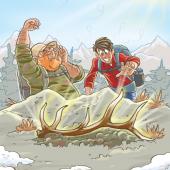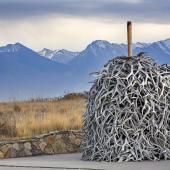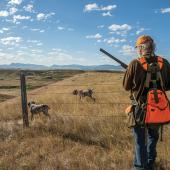Is CRP Land Worth It?
The Conservation Reserve Program (CRP), which is sponsored by the Department of Agriculture, came about as part of the Food Securtity Act of 1985. The basic idea is that farmers and ranchers enter into a multiyear contract (often 10-15 years) with the Department of Agriculture to plant cover crops that are intended to improve water quality, control soil erosion, and enhance wildlife habitat. In return for doing this, farmers and ranchers receive annual rental payments. The average rental payment for CRP land is $51 per acre, and the total 2008 expected outlay equals $1.9 billion.
Not all land qualifies for the plan—in general, only cropland or pasture that has been used for agricultural purposes but could also be suitable for conservation practices like riparian buffers, grass waterways, or shallow water areas for wildlife is eligible.
As of June 30, 2008, 34.7 million acres of the United States were enrolled in the CRP. About 3.4 million acres, or a full 10 percent of all CRP land, is in Montana. In fact, Montana is home to more CRP land than any other state except for Texas, which has 3.9 million acres.
The program's controversy is far-reaching. By essentially paying farmers not to plant, some critics argue the CRP contributes to surging food prices and heightens the separate controversy over ethanol production. Others say the program is crucial to keeping urban sprawl and habitat degradation at bay. We asked Jerry Johnson, who heads MSU’s Political Science department, and George Wuerthner, a local biologist, what they thought.
IT'S A GOOD DEAL
Jerry Johnson
The CRP debate boils down to what you really care about. If you care that marginal agricultural land is pulled out of production for some period of time, then CRP may be a good deal; after all, ten years of forestalling production or development might be enough time to negotiate a conservation easement or other beneficial solution. If you are looking to produce quality wildlife habitat for upland birds, it is also a good deal.
The program isn't without its challenges. In western Montana, between 2001 and 2007, the price of farmland increased on average between 100% and 150% and wheat prices hit $20/bushel. At those prices it won’t be long before many farmers either sell their CRP lands to nonfarmers or plant crops.
But at the same time, many residents of the west, old-timers and newcomers alike, decry the loss of small towns and small-town lifestyles. We like the open spaces and business mix afforded by working farms, and for many landowners CRP helps makes that possible.
Some complain that CRP funds would be put to better use if the land were bought outright. That’s a specious argument. The land is private and there is no reason to believe many farmers would sell—especially when commodities prices and land values are going up. Markets need willing sellers as much as they need willing buyers, and whether a government agency could manage the cost of managing those lands for recreation, wildlife, and the inevitable wildfires is questionable.
Another complaint about the CRP program is the lack of public access. CRP was never meant to provide public recreation. It’s private land; there is no presumption of access, similar to conservation easements or other subsidy programs that make no provision for hunting or recreational access. With over 30 million acres of public land, a thriving block-management program, and thousands of private acres for lease, there is no shortage of recreation access in Montana.
When you consider the inefficiency of corn-based ethanol and the caloric consequences of trying to grow crops to replace oil, the CRP may make some sense as part of an effort to forestall spending millions more subsidizing that fiasco. Remember, land enrolled in CRP is, by definition, marginal—it cannot sustain the intensive production necessary to produce ethanol. The lands would be in even worse condition. That’s not good for anyone.
The CRP strategy should not be abandoned. It has provided an incentive to not farm highly erodable land, which in turn stabilizes the boom-and-bust cycle of agricultural economies. Open lands clearly have social and economic value, and CRP is one way to preserve it. In the morass of wasteful subsidies in the most recent Farm Bill, the CRP seems like a good deal.
IT'S A GOVERNMENT BOONDOGGLE
George Wuerthner
Designed to keep marginal lands out of Ag production, CRP pays farmers and ranchers to retire acreage from commodity production in exchange for an annual rental fee. In 2007 the cost of the program was $1.8 billion. As a comparison, it cost $400 million to operate our entire national wildlife refuge system of 547 refuges—with much higher wildlife benefits.
Farm producers are currently appealing to the Secretary of Agriculture, Ed Schafer, to terminate the contracts. The effort to terminate contracts displays one of the greatest weaknesses of the CRP program—its lack of permanence. CRP benefits are transitory and come at a high price—$36 billion since 1985. It’s time to reconsider its future.
Compared to plowed-row crop land, CRP does reduce soil erosion, improve water quality, and provide wildlife habitat values. However, that is like comparing a Wal-Mart parking lot to a golf course. Just because it’s green and has some plants, the golf course is better for soils, water quality, and wildlife than the pavement. Because cultivated land is about the least valuable wildlife habitat imaginable (far worse than subdivisions, by the way), taking any row crop out of production almost guarantees higher conservation value. The wildlife benefits realized are coincidental and haphazard because enrolling lands is voluntary, and those lands are chosen for reasons other than wildlife habitat value.
The biggest defect I see in the CRP program, besides its huge cost and its haphazard approach to protecting critical wildlife habitat, is its lack of permanence. At the end of the 10- or 15-year contract, any farmer/rancher can decide to start plowing CRP acreage, completely negating any conservation value that may have been achieved.
A focused land-acquisition program would produce far more long-term conservation benefits at less cost than the current haphazard lease system. Public acquisition could permanently remove agriculturally marginal lands from potential subdivision and reduce overall crop acreage, thus ensuring higher prices for crops produced on nonconservation lands. At the same time, public acquisition would result in improved water quality, less soil erosion, and greater wildlife benefits. Plus, the public would realize guaranteed public access for hiking, hunting, wildlife watching, camping, etc.
A similar acquisition of marginal farmland in the 1930s helped to create our national grassland system. Perhaps the recent Ag efforts to terminate the CRP contracts can be an opportunity—a chance to implement a real conservation reserve program that buys, rather than rents, highly erodible lands and provides good wildlife habitat, and public access.












